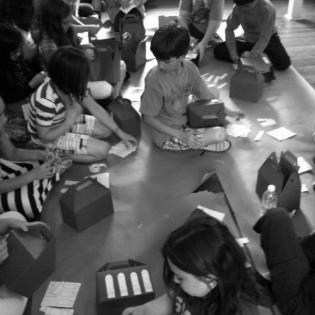Share Your Bread (Private-Religious)
Grades:
K, 1, 2
Keywords & Concepts:
This lesson will help students learn the importance of helping people in need, and teach them to take an active role in helping others. It will allow the students to be aware of what kind of items and quality of items should be donated, how to communicate an idea to others by visual means, and how to speak in front of others.
Duration
PrintOne - Sixty Minute Class Period
Objectives
The learner will:
- demonstrate an understanding of the pasuk in Isaiah 58:7.
- indicate knowledge of the kinds and quality of items that can be donated.
- participate in the decision-making process of how to collect and where to store donated items.
- take an active role in organizing and running the drive.
- communicate to others the importance of participating in the drive.
- influence others to donate to the drive through writing or speech.
Materials
- Large boxs for collecting items
- Poster with brochures about the organization/facility to which the items will be donated (containing photos)
- Samples of appropriate and inappropriate items for the class drive
- Art materials/supplies for creating posters
Home Connection
Students will bring from home an item (e.g. clothing, non-perishable food) to donate to the drive.
Bibliography
- The Bible – Isaiah 58:7
Instructions
Print
-
Anticipatory Set:Display the poster with the brochures in front of the class. Put the quote from the last lesson on the board: “Share your bread with the hungry and bring the poor that are cast out into your home. When you see the naked clothe them.” (Isaiah 58:7)
- Review what the pasuk means.Ask the students to state how they decided to put the quote into action (e.g. clothing drive; canned food drive).Review the concept of tzedakah.
- If the class is organizing a clothing or toy drive, discuss which types of clothing can be donated.Show the students samples of gently-used clothing or toys and compare with examples of worn items.Discuss what the quality of the clothing and toys should be and explain why only gently-used items should be donated.
- If the class is organizing a food drive, teach the students the concept of perishables and non-perishables. Bring samples of appropriate items and ask them why only non-perishables should be donated to the food drive.
- Tellthe students of the organization/ facility to which they will be sending the collected items, and to which population they will be distributed.Show the students the photographs in the brochures that illustrate what the organization/ facility does.
- Help the students brainstorm ways to efficiently collect and store the items.Help them organize an area of the classroom or school for the collection.
- Assign different jobs to the students (Simplify jobs and provide assistance, as needed.):
- Write a letter to parents announcing the drive they are organizing and state the reason for it.
- Prepare a brief oral presentation to give to the other classes announcing the drive.Within the presentation they should mention the concept of tzedakah.The teacher should give the students tips on speaking effectively (e.g. speaking slowly, loudly and clearly, and making eye contact).
- Pairs of students give their presentations to the other classrooms (adult should accompany them).
- Create colorful and creative posters or advertisements to post around the school.The class can brainstorm the necessary information to be included on the posters.The teacher should provide appropriate materials.
- Gather boxes for collecting.
- Create a storage area for items ready to be delivered.
Assessment
Assessment is based upon the students’ participation/performance in discussions, posters, letters, and/or presentation.
Cross Curriculum
Students will actively participate in all aspects of the class drive to collect items to donate to a chosen charity.They will plan, manage, and advertise the drive to parents and/or other students.
Philanthropy Framework
-
Strand PHIL.IV Volunteering and Service
-
Standard VS 01. Needs Assessment
-
Benchmark E.1 Identify a need in the school, local community, state, nation, or world.
-
-
Standard VS 03. Providing Service
-
Benchmark E.1 Provide a needed service.
-
Benchmark E.3 Describe the task and the student role.
-
-
